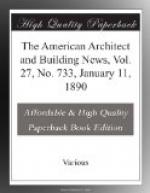The streets of Egyptian cities were usually laid out regularly, but they were so narrow that, except in the principal ones, two chariots could scarcely pass. This narrowness of the streets, which is frequently observed in the ancient Arab cities, and which has been so long maintained in all hot countries, had the advantage of securing shade at all times on one side of the street. The buildings along the street were ordinarily separated from each other by alleys; they were rarely more than two stories high, except in such large cities as Thebes, where they sometimes reached four and even five stories. The houses were so arranged as to meet the demands of the climate. A court often preceded the apartments which were disposed along both sides of a long corridor. In other cases the rooms occupied three sides of the court; or oftener still the court was surrounded on all sides by the different structures. The ground-floor was reserved for the stables; it was used also for storing the corn, and it contained the kitchen and the cellar. The family occupied the upper stories. Above the whole was a terrace where they could enjoy the cool air and even pass the night, when the heat was excessive. Sometimes the terrace was protected by a light roof supported by slender wooden columns. There were but few windows, so as to keep the sun out as far as possible, and such as there were were placed nearly at the top of the rooms.
The houses were built of unburned brick, made from a heavy clay, mixed with a little sand and chopped straw; this was shaped into oblong slabs which were dried in the sun. Bricks of ordinary size measured 8-2/3 in. x 4-1/3 in. x 5-1/2 in., the large ones were 15 in. x 7 in. x 5-1/2 in. There were special marks to indicate where they were manufactured; some came from the royal works, some from private shops. The foundations of the buildings were not deep; the walls were whitewashed, or painted in bright colors; the floors were of brick or flagging, or simply of hardened earth; the roof was flat, with a framework of palm branches covered with a coating of earth sufficiently thick to prevent the infiltration of the rain. The dwellings of the wealthy lords were usually erected in the centre of a garden, or of a cultivated court, and occupied a considerable space. The entrance was announced by a colonaded porch or a pylon, and the interior was like a small city,—the dwelling in the background, with the granaries, stables, servants’ quarters and out-buildings disposed here and there about the enclosure.
In the more important palaces, the dwelling of the master stood in the centre of a rectangular court, the sides of which, on the right and left, were occupied by the storehouses.
Like all other peoples of antiquity, the Egyptians were obliged to protect their towns from the incursions of enemies. The greater part of their cities, and even the principal villages, were therefore walled. Man will never cease to fortify his cities until these fortifications have been proved unavailing before the power of new engines of destruction.




